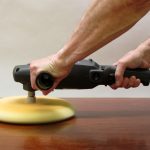We may receive a commission when you use our affiliate links. However, this does not impact our recommendations.
 The doe’s foot – a block of wood with a “V” cut into it – is one of the most versatile and cheap appliances for your workbench. I have an article about this little gizmo coming up in the next issue of Popular Woodworking Magazine (look for it in the November 2017 issue, or perhaps subscribe).
The doe’s foot – a block of wood with a “V” cut into it – is one of the most versatile and cheap appliances for your workbench. I have an article about this little gizmo coming up in the next issue of Popular Woodworking Magazine (look for it in the November 2017 issue, or perhaps subscribe).
I work with a lot of odd-shaped parts, especially when I build chairs. These components can be curved and comprise compound angles. No tail vise could hold them. Face vises marr them (no matter what your jaws are lined with). And clamping them to the benchtop is unwieldy.
Many times, the solution is a doe’s foot or two.
A Doe’s Foot in Use
Last week as I finished up a chair commission I had to plane the long edges of the chair’s crest rail without damaging the piece. Clamping it in the face vise dings up a crest unless it is swaddled in thick felt (which I did not have). Clamping this between dogs was impossible because the ends of the crest are compound angles. If I wanted the dogs to grip the work I was going to have to damage the work by cranking the tail vise hard.
There are lots of ways to hold a crest that involve handscrews and clamps. But I’m always looking for a simpler solution. I want a solution that won’t mark the work.
Using two doe’s feet was the answer. One in front of the work and one behind. These two appliances captured the crest without marking it. It was easy to plane the edges clean.
I now have six of these doe’s foot appliances stacked below my bench, ranging in thickness from 1/8” to 1”. They are humble and beaten-up pieces of wood, but they are remarkably useful.
— Christopher Schwarz
If you want to learn more about the doe’s foot, check out the revised edition of “Workbenches: From Design & Theory to Construction & Use” at Shopwoodworking.com.
Here are some supplies and tools we find essential in our everyday work around the shop. We may receive a commission from sales referred by our links; however, we have carefully selected these products for their usefulness and quality.









Has anyone written/created the comprehensive book on all the ways to clamp things to a bench. I have seen many great pictures showing a dozen ways to clamp a drawer to a bench for planing. These gems have saved me hours of frustration. The picture at the top of this post is worth thousand words. I would buy this book if it exists. Clamps, cramps, does foot, hold fast, plane stops, moxons, etc.
To be clear.. I’m interested in objects clamped to the bench for working, sanding, planing, cutting, moulding. Not pics of clamped up carcass or cutting board.
Maybe Chris, or someone at PW who is not a busy, could identify themselves as the recipient of emailed photos. Anyone with a cool time saving, life saving clamping method could send the pic to PW- they could collect them for a year and publish….. unless it already exists… then I’ll thank you to send me a link.
I’m interested in how it got the name Doe’s foot. I know it has the shape of the animals foot. While the saw benches has the same shape and is called a ducks mouth. Is it because the angle and width is wider on the Doe’ foot.
A handscrew works well for this application too. You can attach the handscrew to one end of the work piece. Then clamp the handscrew to the bench. It works great for difficult to hold pieces.
I was trying to plane the EXACT same thing last night! I ended up using an awkward combination of F-clamps and positive thoughts. It sort-of worked.
How did you secure the other doe’s foot? Cramped it with the tail vise? Or maybe another holdfast while squeezing the DF against the work with your free hand?
That eccentric clamp thing Roy made from a kids’ project book would work great for this one.
Hail.
I disagree with your assessment of the use of a tail vise in this instance. I happen to have one on my bench and it seems to be made for a piece like that. I find that when I use my tail vise, I do not have to crank it hard at all. If marring the piece were to be an issue, I think I would use rubber pads; however, I did not have a need for them yet. Recently, I clamped some fairly long, thin pieces in the end vise. The pieces gave quite a bit when I used a small plane to round over the edges, but I did not find that to be a problem. They certainly did not come loose.
Yes more jigs please.